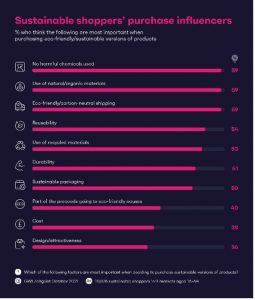By Harold Weghorst
When brands talk about sustainability, they often cite that the primary objective is to “raise awareness”. By “raising awareness” brands can better engage customers, communicate their initiatives and better promote their sustainable products and ethos. But now it’s time to evolve the conversation. To remain competitive and more importantly, achieve greater sustainability results, brands should look to evolve their messaging from awareness to action.
Actioning sustainability goals and objectives is the only way forward to achieve the results needed to be truly eco-friendly. Consumers today will prioritize fashion brands that embed sustainability into their operations, set realistic ambitions, and make positive change. Brands that create sporadic and ineffectual campaigns, which function as an extension of greenwashing, will be left behind.
Sustainability Has A Domino Effect
Change starts with the brands and manufacturers at the beginning of the textile supply chain, and when they take action, their efforts create a domino effect that cascades through the supply chain onto the customer. Efforts to reduce carbon emissions and curb the reliance on fossil fuels don’t go unnoticed by consumers. In fact, the emergence of the “conscious consumer” has provided brands with the ability to reconcile the need to meet business objectives while doing good for the environment. This is evidenced by changing consumer habits.

According to a survey conducted by Global Web Index, nearly two in three consumers who describe themselves as fashion-conscious would rather pay more for an eco-friendly product.* Sustainable shoppers are guided by a myriad of factors, but three factors are highlighted as the most important considerations when making a purchase decision — no harmful chemicals, use of natural/organic materials and eco-friendly/carbon-neutral shipping. The challenge for brands is how they justify an increased cost on their products as a result of catering to these factors. Only by being transparent about their manufacturing and communicating their sustainable value proposition to consumers can they differentiate. Consumers should be shown exactly how an increased cost for their garment, yields mutual benefits for their wardrobe and their planet.
Brands That Go Green, Make Green
Fast fashion is easy to produce, it provides an abundance of choice and can be made in mass quantities. Many brands often turn to man-made fibers like polyester to produce their garments. However, in order to really preserve our environment, the industry has a collective responsibility to adopt sustainability in all levels of the supply chain, from fiber, consumption, recycling and disposal.
To implement sustainability for brands, action is key. Half measures and reputational band-aids do little to alleviate the disastrous impact that fossil fuel reliant synthetic fibers have on both the environment and people[2]. Instead, brands and manufacturers must calibrate their revenue approach to include sustainable consumers with big pockets. They can do this by developing impactful campaigns, setting achievable sustainability goals and finding creative ways to involve their consumers beyond just selling clothing to them. This post-sale brand interaction and ongoing education to consumers is where sustainable brands can gain a competitive advantage and really perform in the market for the long run.
How We Do Campaigns: #MakeItFeelRight In Action
When Lenzing’s TENCEL™ brand’s #MakeItFeelRight campaign launched back in 2019, it did so with the firm objective to raise awareness around the negative environmental impacts caused by the fashion industry. Last year, the campaign sought to garner social media pledges from consumers who created fun and exciting posts that showed off their sustainable clothing. For the initiative, TENCEL™ partnered with One Tree Planted, an environmentally conscious NGO which planted a tree for every pledge generated.

This effort to debunk the myth that sustainable fashion is not stylish generated more than 8,000 pledges, a huge contribution to global reforestation efforts.
Any brand that wants to uphold their sustainability commitment should inspire their supply chain partners to follow suit, transition awareness to real action and most importantly practice what they preach!
* GWI, Fashion for good: why sustainability is on trend https://blog.gwi.com/chart-of-the-week/sustainable-fashion/
** Changing Markets Foundation: Fossil Fashion Report https://changingmarkets.org/portfolio/fossil-fashion/
Editor’s Note: Harold Weghorst is global vice president, Marketing & Branding, Austria-based Lenzing AG
January 28, 2022




